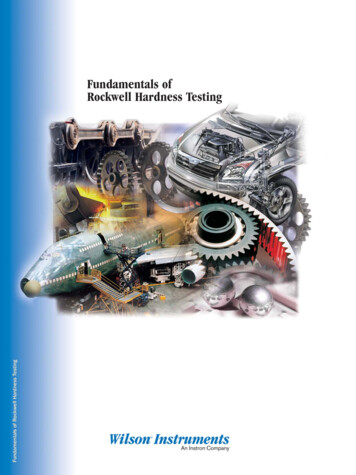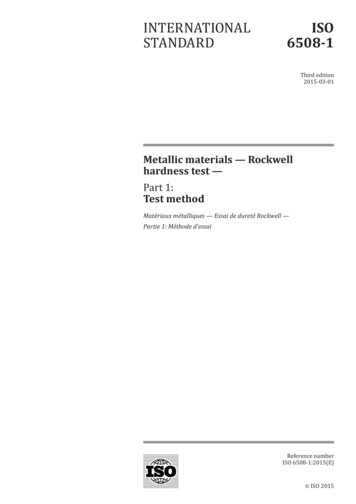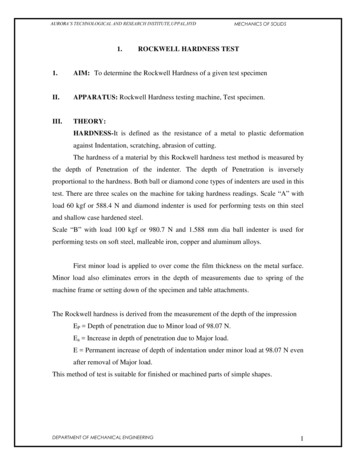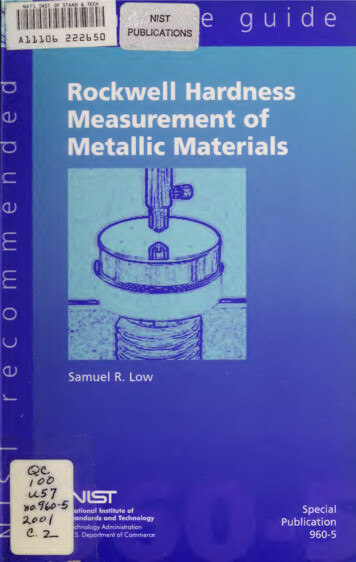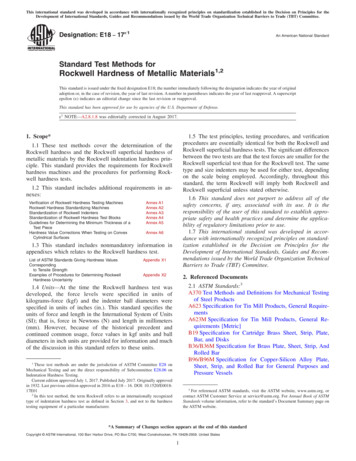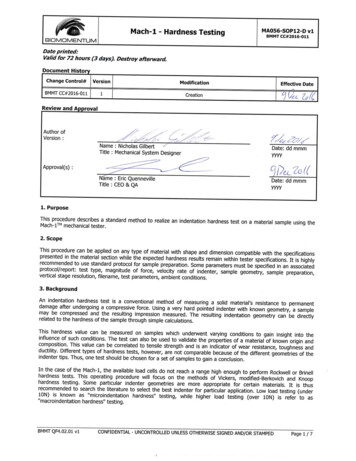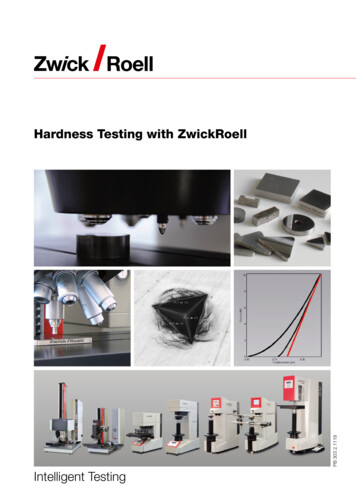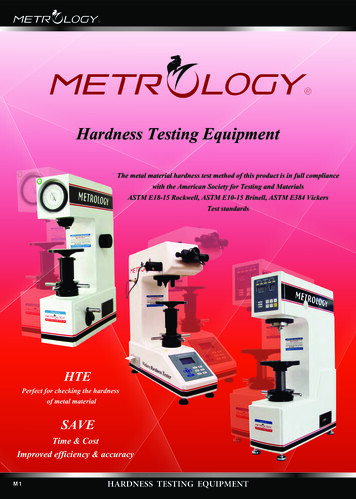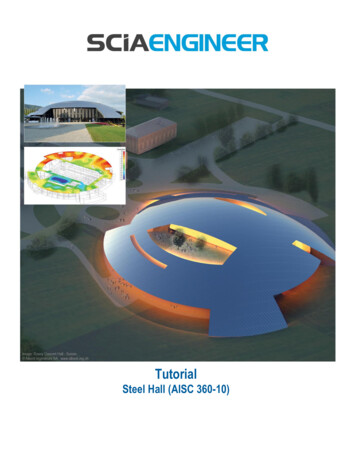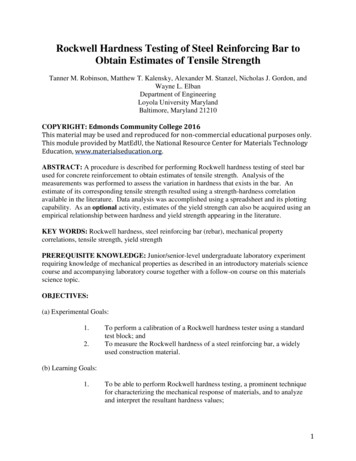
Transcription
Rockwell Hardness Testing of Steel Reinforcing Bar toObtain Estimates of Tensile StrengthTanner M. Robinson, Matthew T. Kalensky, Alexander M. Stanzel, Nicholas J. Gordon, andWayne L. ElbanDepartment of EngineeringLoyola University MarylandBaltimore, Maryland 21210COPYRIGHT: Edmonds Community College 2016This material may be used and reproduced for non-commercial educational purposes only.This module provided by MatEdU, the National Resource Center for Materials TechnologyEducation, www.materialseducation.org.ABSTRACT: A procedure is described for performing Rockwell hardness testing of steel barused for concrete reinforcement to obtain estimates of tensile strength. Analysis of themeasurements was performed to assess the variation in hardness that exists in the bar. Anestimate of its corresponding tensile strength resulted using a strength-hardness correlationavailable in the literature. Data analysis was accomplished using a spreadsheet and its plottingcapability. As an optional activity, estimates of the yield strength can also be acquired using anempirical relationship between hardness and yield strength appearing in the literature.KEY WORDS: Rockwell hardness, steel reinforcing bar (rebar), mechanical propertycorrelations, tensile strength, yield strengthPREREQUISITE KNOWLEDGE: Junior/senior-level undergraduate laboratory experimentrequiring knowledge of mechanical properties as described in an introductory materials sciencecourse and accompanying laboratory course together with a follow-on course on this materialsscience topic.OBJECTIVES:(a) Experimental Goals:1.2.To perform a calibration of a Rockwell hardness tester using a standardtest block; andTo measure the Rockwell hardness of a steel reinforcing bar, a widelyused construction material.(b) Learning Goals:1.To be able to perform Rockwell hardness testing, a prominent techniquefor characterizing the mechanical response of materials, and to analyzeand interpret the resultant hardness values;1
2.3.To be able to obtain estimates of tensile strength using the hardnessmeasurements; and(Optional) To be able to acquire estimates of yield strength using thehardness measurements.TYPE OF MODULE: Laboratory experimentTIME REQUIRED: Hardness testing takes no more than 30 minutes; see Instructor Note 1.MODULE LEVEL: Intermediate undergraduateMatEdU CORE COMPETENCIES COVERED:0.A0.B1.C2.B3.A3.B4.A8.A8.B8.EDemonstrate good communication skillsPrepare tests and analyze dataDemonstrate laboratory skillsDemonstrate proper use of units and conversions (for Optional activity)Practice appropriate computer skills and usesDemonstrate use of computer applicationsDemonstrate effective work with teamsDemonstrate the planning and execution of materials experimentsApply mechanical testing processes to solid materialsPerform appropriate tests of metallic materialsTABLE OF CONTENTSAbstractObjectivesModule dataMatEd core competencies coveredMaterials and equipment requiredIntroductionModule procedureCommentsInstructor notesReferencesMaterial sourcesAcknowledgementsAbout the authorsTables and FiguresAppendix AEvaluation packet11222357810121213152023EQUIPMENT AND MATERIALS: (1) Instron Wilson Rockwell hardness tester (modelR2000) equipped with a 1/16 in. steel ball indenter; (2) Rockwell test standard (Wilson blockserial no. 90041481; B scale hardness, HRB 79.4 1.0); (3) two or four steel reinforcementbar specimens (variable diameter depending on rebar designation and nominally 1/2 in. long); (4)Wilson (Hardness) Conversion Chart 60.2
SAFETY PRECAUTIONS: No particular safety precautions are necessary. However, caremust be taken to avoid moving the sample once the hardness tester commences itsoperating cycle. Sectioned samples, although deburred, may have sharp circumferentialedges requiring careful handling to avoid fingers being cut.INTRODUCTION:General Background: Indentation hardness testing is a commonly used characterizationtechnique to acquire information about the mechanical behavior of materials. Two basicmethodologies have been developed that involve applying a constant load to an indenter of givenshape such as ball, cone, or pyramid. One approach involves optically measuring a characteristicdimension of the resultant (plastic) impression once the indenter is removed. This measurementallows calculation of a hardness pressure by dividing the applied load by either a contact area(Brinell or Vickers hardness test) or projected area (Meyer or Knoop hardness test). The secondapproach was developed by S.P. Rockwell. A direct reading appears on an analog or digitaldisplay based on the measured change in penetration depth during a test cycle in which apreliminary force (minor load) followed by a total force (major load) is applied, both for fixeddwell times. The Rockwell test was chosen in this work because it is simple to conduct andprovides reliable results when certain “best practices” [1,2] are carefully followed.Correlating hardness with mechanical properties determined from analyzing the stress-straincurve obtained from performing a uniaxial tensile test has been a topic of considerable interest.This is the case because hardness testing set-up and operation are much simpler and specimensof irregular size and shape can be readily characterized. It is widely used as a quality controltool for as-manufactured parts, something that is usually impossible with tensile testing due to itsprescriptive sample geometry and dimension requirements. Correlating hardness with tensilestrength, a readily identifiable feature on an engineering stress – engineering strain curve, isgenerally considered to be most reliable; their relationship has been established experimentallyby obtaining hardness and tensile strength results on the same materials. Correlating hardnesswith yield strength has also been investigated, but this relationship has higher uncertaintybecause an empirical numerical constant typically taken to be 3 is used to relate the two materialproperties [3].Concrete is widely regarded as an affordable material that exhibits good mechanical propertieswhen subjected to compressive loads. However in tension, concrete is seen to have roughly1/10th the load bearing capacity compared to when tested in compression. In hopes ofexpanding upon the variety of possible applications of concrete, efforts have been made toimprove the properties of concrete in tension. A metal component was incorporated in aconcrete matrix in order to create a material with overall better mechanical properties andspecifically to lessen the undesirable fault regarding concrete's limited ability to withstand tensileloads. The metal component used in this reinforced concrete is known as reinforcing bar (rebar)and is typically a form of low carbon steel. It is understood that steel has markedly better tensileload bearing capabilities than concrete. Additionally, rebar and concrete have similarcoefficients of thermal expansion and easily bond together. Therefore, temperature changes donot lead to catastrophic failures due to different thermal expansions of the two materials. Sincethese two materials are deemed to be compatible, the idea behind reinforced concrete is that the3
rebar will improve the mechanical properties of the resulting material. Rebar is typically madeby hot rolling steel billets into rod-shaped material that has been shaped to have ridges withvarious geometric designs on the exterior longitudinal surface. (Instructor Note 2)Problem Statement (Instructor Note 3): You have recently been hired as an engineer by amaterials testing and consulting firm. The company president is intrigued by a recent article ontensile testing steel concrete reinforcing bar (rebar) [4]. Recognizing the projected growth innew construction over the next decade and the increasing awareness of the nation’s deterioratinginfrastructure, particularly roads and bridges, a decision was made to launch a program toinvestigate the mechanical properties of rebar obtained from various places, both new comingfrom numerous domestic and foreign sources and recovered from several existing structures.Your part of the program involves an initial screening of materials received for tensile testing byperforming Rockwell hardness testing on the sample provided to accomplish four (4) primaryoutcomes:(a) Assessment of hardness uniformity throughout bar cross-sectional area;(b) Estimation of the tensile strength (TS) of the rebar using the measured Rockwell hardnessvalues;(c) Assessment whether it is possible for the rebar to be ASTM A36 steel as some suppliershave claimed, based on the TS determined. (Obviously, more characterization such aschemical analysis would be needed to substantiate your conclusion.); and(d) Assessment of rebar classification using the ASTM A615 product standard with the sameItem (c) disclaimer above and assuming the rebar being tested meets all other requirementsappearing in the specification.Schedule:Pre-lab class Special laboratory problem introduced accompanied with preliminary instructions(15 minutes)Note your team number for pre-established three- or four-member teams postedon the Internet (Moodle). (Instructor Note 1)Homework: Read References [4] and [5]Class #1First half of the teams: 25 minutes in Materials Lab; receive rebar specimens.(Instructor Note 4)Second half of the teams: 25 minutes in Materials Lab; receive rebar specimens.(Instructor Note 4)(1) Receive instruction on using Rockwell hardness tester.(2) Perform hardness testing on calibration block as a test example.4
(3) Discuss performing hardness testing on rebar specimens provided (actualaccess time(s) to tester scheduled using a sign-up sheet to accommodate all of theteams during the week).Homework: Read References [2] and [6] (background reading on Rockwellhardness testing issues).Class #2(1) Enter Rockwell B scale hardness and tensile strength data appearing in Table6 (Reference [5]) or alternatively in Wilson (Instron) Desk Chart 60 [7], for softsteel, gray and malleable cast iron and most non-ferrous metals, into Excel (orequivalent) and plot tensile strength as a function of Rockwell hardness andobtain an appropriate trend line for the data with accompanying R2 value.(2) Perform internet research on the following topics:(a) rebar: how it is made, compositions, and mechanical properties;(b) ASTM A36 steel standard: mechanical properties and possibleaccounts of it being used in rebar; and(c) ASTM A615 steel rebar standard: grade classifications andcorresponding mechanical properties.Homework: Read References [8] and [9] (background reading on rebar).Class #3(1) Complete remaining testing and complete data analysis.(2) Discuss the results and draw technical conclusions as a team.(3) Prepare outline of written report and delegate work among team members.Post-lab class Submit group (team) written report.PROCEDURE:A. EXPERIMENTAL1. Rockwell hardness testingBefore commencing sample testing, it is necessary to verify that the hardness tester isworking properly. (Instructor Note 5) The objective of this work is to perform Rockwellhardness testing on the cross-sections of the provided steel rebar specimens using an InstronWilson Rockwell R2000 tester.Record measurements and any relevant observations with appropriate drawings.(1) Perform a calibration measurement on a standard Rockwell B scale test block placedon the flat anvil of the tester such that the surface to be indented is orthogonal to theindenter axis. If the measurement lies outside the specified range (In this case, HRB 79.4 1.0.), repeat the measurement since properly seating the block can be an issue.5
(2) Obtain a series of typically four to six hardness measurements on the cross-sectionalareas of each of two (2) or four (4) specimens. (Instructor Note 4)B. ANALYSISPerform the following analyses and respond to any questions as completely as possiblebeing sure to show all of your work and reasoning as partial credit can be earned.1. Rockwell hardness measurements to obtain tensile strength estimatesa.Compute the average and standard deviation for the hardnessmeasurements obtained for each specimen. Discuss and compare theuniformity in hardness of each specimen.b.Using Excel (or equivalent), create a properly labeled plot of tensilestrength, ksi, versus Rockwell (B scale) hardness (HRB) given inReferences [5,7]. Obtain the appropriate trend line equation with R2 valueand discuss the trend that exists.c.Using Excel (or equivalent), determine the estimated tensile strength foreach rebar specimen utilizing the equation for the trend line in the plotprepared for Item 1.b.d.Using the estimated tensile strength values, assess whether the rebarsample could possibly be A36 steel [10].e.Using the estimated tensile strength values, classify the rebar sample usingthe A615 product standard [11].2. (Optional) Rockwell hardness measurements to obtain yield strength estimatesa.Using Excel (or equivalent), create a properly labeled plot of Brinellhardness (HB) determined using a 500 kgf load and a 10 mm ball as afunction of Rockwell (B scale) hardness (HRB) obtained for soft steel,gray and malleable cast iron and most non-ferrous metals as given inWilson (Instron) Desk Chart 60 [7]. Obtain the trend line equation withR2 value and discuss the trend that exists.b.Using Excel (or equivalent), determine the corresponding HB value (usingthe equation for the trend line in the plot prepared for Item 2.a) for eachrebar specimen.c.Convert the HB value to a Meyer hardness (HM) value usingHM 4P/πdp2,(1)6
where P is the applied load (500 kg) on the indenter, and dp is the diameterof the projected circular area of the indentation. The quantity dp2 isdetermined from the equation used to calculate HBHB 2P/{πD[D – (D2 – dp2)0.5]},(2)where D is the ball diameter (10 mm).d.Determine corresponding estimates of yield strength, σy, for the HMvalues for each rebar specimen using the empirical relationshipHM cσy,(3)w
performing Rockwell hardness testing on the sample provided to accomplish four (4) primary outcomes: (a) Assessment of hardness uniformity throughout bar cross-sectional area; (b) Estimation of the tensile strength (TS) of the rebar using the measured Rockwell hardness values;File Size: 311KBPage Count: 23
